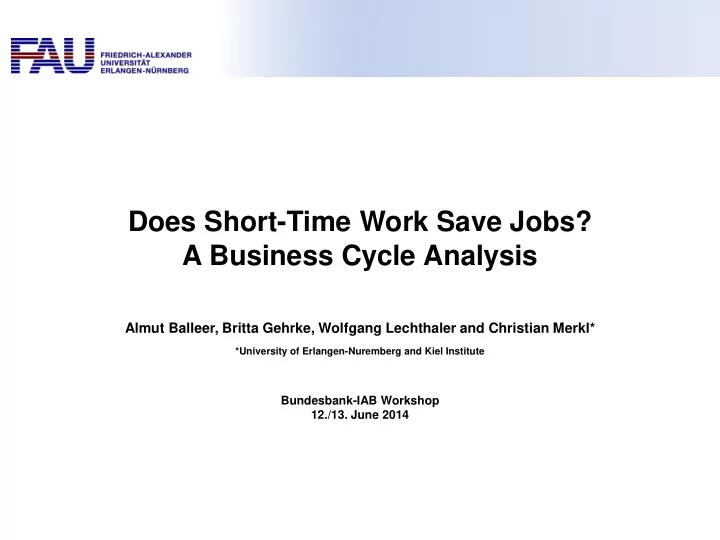

Does Short-Time Work Save Jobs? A Business Cycle Analysis Almut Balleer, Britta Gehrke, Wolfgang Lechthaler and Christian Merkl* *University of Erlangen-Nuremberg and Kiel Institute Bundesbank-IAB Workshop 12./13. June 2014
Motivation "Germany came into the Great Recession with strong employment protection legislation. This has been supplemented with a “ short-time work scheme ,” which provides subsidies to employers who reduce workers’ hours rather than laying them off. These measures didn’t prevent a nasty recession, but Germany got through the recession with remarkably few job losses." (Paul Krugman, 2009) • This paper argues that it is important to distinguish the automatic and discretionary components of STW. • Key result: only automatic component stabilizes employment, while the discretionary component does not seem to be an important stabilizer. 2
The Paper on One Page Automatic component: Quantify with micro-data Identify Calibrate SVAR Model Simulation: SVAR: Discretionary component 1) Mechanism & intuition 2) Automatic component No effects on Automatic component: Strong (un)employment employment stabilization 3
STW: Two Margins 4 STW: intensive margin procyclical
Estimating a Micro-Elasticity • What is the automatic response of STW with respect to output changes? • Data: IAB establishment panel Fraction of STW Expected in employment revenue • Fixed effects estimations, Tobit and Heckman selection model • Range of estimated elasticities : −3.31 to −7.84 5
SVAR Strategy • Structural VAR in the tradition of Blanchard and Perotti (2002) • Setup: – Bivariate VAR with a non-policy (GDP) and a policy variable (STW/EMP) – Baseline specification for 1993 Q1 to 2010 Q4 • Identification: – Separate two shocks: business cycle shock and policy shock • Key assumptions: – Policy does not immediately react to GDP shocks – The effect of GDP shocks on the policy variable then exclusively measures the automatic output elasticity of the policy variable • Micro-estimate of the elasticity is imposed as short-run restriction 6
SVAR-Results: Baseline 7
The Model in Words • Dynamic search and matching model • Endogenous separations • Business cycle shocks • Unprofitable worker-firm pairs are eligible for STW • Hours adjustment subject to quadratic adjustment costs • Model is calibrated to match the elasticity of STW with respect to output. • Interesting: Intensive margin of STW is procyclical in simulation. 8
Separations: Economy without STW • Firing cutoff: • Endogenous separations: 9
Short-Time Work STW subject to quadratic costs Discretionary component: vk moves to the left 10
Results of Discretionary Policy (Temporary) 11
Results of Discretionary Policy (Persistent) 12
Stabilization Effects • Simulation of two economies (with and without STW). • Driving force: Productivity shocks with autocorrelation 0.95 and standard deviation 0.01. 13
Intermediate Results from Simulation • Automatic component of short-time works as a strong business cycle stabilizer. • Comparison: Income tax system stabilizes output fluctuations by 6-30% (compare in’t Veld et al. 2013). • But the income tax system is more than 10% of GDP (in most OECD countries), while STW costs divided by GDP < 0.1% of GDP. 14
Counterfactual Exercise: Short-Time Work in the US • Individual bargaining, zero firing costs, US labor market flows 15
Short-Time Work and the Great Recession • 6.6 percent decline of GDP should have generated a (peak) increase of unemployment of 4.8 percentage points (according to the SVAR). • Model prediction: STW prevented an increase of unemployment of 1.3 percentage points (i.e. 466,000 jobs). • Thus, STW is certainly only one factor among many to explain the German “labor market miracle” (Möller 2010). • Altough we use a completely different methodology, our Great Recession results are roughly in line with Boeri and Bruecker (2011) and Burda and Hunt (2011). 16
17
Business Cycle Shock 18
Discretionary Interventions Maximum duration 19
Labor Adjustment over the Business Cycle in Germany 20
VAR-Results: Robustness 21
Recommend
More recommend